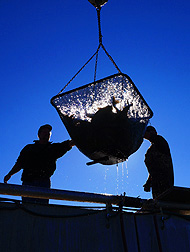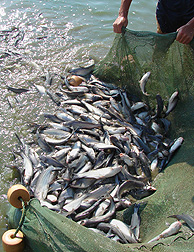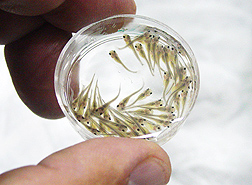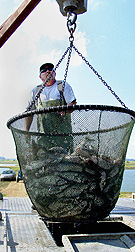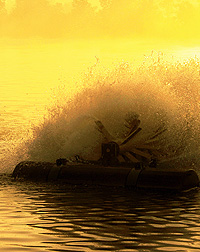Producing Better Catfish the Hybrid Way
The catfish once ranked pretty far down among fish species as a lowly bottom feeder, but that was when it could only be caught in the wild. With the birth of freshwater catfish farming in the 1960s, the catfish has made a big splash, netting the number-one spot in the U.S. aquaculture industry.
However, in recent years, U.S. catfish producers have been struggling to keep their heads above water, avoiding the waves of a slow economy, high feed costs, and fish imports from foreign countries. Sales of catfish products were down to about $341 million in 2012 from $423 million in 2011, and acreage has declined in the major catfish producing states—Alabama, Arkansas, Louisiana, and Mississippi.
To help farmers, Agricultural Research Service scientists in the Warmwater Aquaculture Research Unit (WARU) and their Mississippi State University (MSU) colleagues at the Thad Cochran National Warmwater Aquaculture Center in Stoneville, Mississippi, are looking at breeding, nutrition, genetics, and management practices to produce a better catfish. For decades, it’s been known that hybrid catfish—a cross of the fast-growing channel catfish with its close relative, the slower growing and larger blue catfish—generally have better growth, higher survival, and better meat yield than either channel or blue catfish. But hybrids have been difficult to produce in large quantities. That’s changing.
Hybrid catfish production has increased substantially—comprising about 20 percent of catfish harvested in 2011. In 2007, catfish hatcheries produced 30 million hybrid fry. That number is now estimated to be 150 million hybrid fry.
ARS scientists have refined the hybrid breeding process and are taking the technology directly to catfish farmers. “Our hybrid work is based on solid science, but what’s making a tremendous impact is our outreach effort to get the technology out and rapidly implement it in the industry,” says WARU researcher leader Craig Tucker.
How To Make a Hybrid
“Our best chance for a quick impact on hybrid production was to help farmers learn how to make what we call the ‘fry,’ or baby fish, which was new to them,” says geneticist Brian Bosworth.
Bosworth and geneticist Nagaraj Chatakondi are conducting workshops for farmers, in collaboration with MSU scientists, to demonstrate how to produce hybrid catfish fry in hatcheries. They also give on-site consultations at hatcheries.
To produce channel catfish, farmers typically place “spawning cans” in ponds containing mature males and females, Bosworth says. The females lay eggs inside the cans, and the males then fertilize the eggs.
The hybrid catfish, however, is a cross between two different species that do not mate with each other naturally. Hybrid fry production involves hormone-assisted reproduction. The female channel catfish is given a hormone injection, which induces her to ovulate—release eggs. The fish is anesthetized, and eggs are “stripped,” meaning gently pushed out. Sperm taken from blue catfish males is mixed onto the eggs. Hands-on training involves teaching farmers the process, ensuring that the hormone dosages and egg and sperm preparations are right, and dealing with any other issues.
“Once eggs have hatched, production is pretty much the same as with regular channel catfish,” Chatakondi says. “The only difference is that hybrid catfish generally grow much faster and are easier to harvest and process. Farmers can increase production 20 to 30 percent by using hybrids instead of channel catfish.”
Still, many farmers prefer channel catfish because fry production costs are lower than those for hybrids, and more channel fingerlings (juvenile fish) are available.
Overcoming Inefficiencies in Hybrid Production
Factors such as inconsistencies in egg quality and suboptimal hatching conditions increase the cost of hybrid fry production. “We need to find ways to improve efficiency of hybrid embryo production in catfish hatcheries,” Chatakondi says.
One approach is to look at the effects of water quality, such as its calcium content, or “hardness,” on the hatching success of eggs. Working with fish biologist Les Torrans, Chatakondi incubated fertilized hybrid eggs in waters containing four levels of calcium hardness to determine which level yields the highest hatching success. The calcium hardness levels ranged from 25 milligrams per liter to 100 milligrams per liter—levels maintained by commercial hybrid hatcheries. They found that lower calcium levels may reduce hatchability and increase vulnerability to diseases.
“We recommend a calcium hardness level of 75 milligrams per liter in waters to hatch hybrid catfish eggs,” he says. “Optimal levels improve the egg-hatching success and may contribute to a lower cost of producing hybrid fingerlings.”
Additionally, not all eggs are created equal. Hormone-induced fish often ovulate eggs that vary in quality due to variation in brood fish maturity, husbandry, nutrition, genetics, and mechanical damage during manual spawning. Poor-quality eggs are more vulnerable to fungi, which could spread to healthy eggs.
Chatakondi developed a method, which can be easily adopted in catfish hatcheries, to identify poor-quality eggs before they hatch. He found that the pH level of ovarian fluid of stripped channel catfish eggs prior to fertilization can be used to predict hatching success in hybrid embryos.
It appears that a pH level of more than 7.0 is indicative of better quality eggs, and using egg lots of this pH or higher can improve hatching rate, Chatakondi says.
Genetic Tools for Breeding
Scientists are constructing a genetic map of the catfish genome to identify chromosomal regions that control significant traits—such as meat yield and disease resistance—that are essential for selective breeding programs.
Molecular biologist Geoff Waldbieser has developed DNA markers to analyze channel catfish parentage and kinship to determine genetic diversity, produce pedigree populations, and identify markers associated with important traits. This technology is being used to learn more about genetic background to further improve hybrid performance. In a recent study, hybrids were grown in ponds and then measured for growth and meat yield. The analysis indicated the presence of substantial genetic effects of parents on offspring performance.
“This shows we can improve hybrid catfish growth and carcass yield by selecting superior female channel catfish and male blue catfish as parents,” Bosworth says.
Waldbieser also designed a rapid DNA-based test that identifies and distinguishes channel, blue, and hybrid catfish within 24 hours at all life stages, from 1 day after fertilization to a cooked fillet. “The test is a useful tool for hybrid production management and postharvest detection of hybrid catfish products,” he says.
|
|
In other research, physiologist Brian Peterson investigated the relationship between catfish growth, immune function, and genes during early stages of development. Egg samples were taken before and after fertilization, and embryos were collected at hatch and at “swim-up”—the stage when fry are not yet sexually developed.
Peterson examined changes in gene expression of insulin-like growth factors (IGFs) and toll-like receptors (TLRs), molecules involved in the induction of the immune response, in hybrid and channel catfish. Over time, gene expression levels of TLR5 and IGF-I mRNA increased in channel catfish. In hybrids, TLR3, IGF-I, and IGF-II mRNA increased.
“It was known in mammalian species that IGF-II played a primary role in fetal development. The biggest surprise in our catfish studies was that IGF-II plays a role in both fetal development and juvenile growth,” Peterson says. “IGF-I in catfish also plays a role during fetal development and growth.”
Making the Grade Against Disease
Proliferative gill disease (PGD) is one of the most devastating parasitic infections affecting catfish. The deadly disease damages the gills of fish and decreases their ability to get oxygen from water.
To find out if hybrids are more or less susceptible to PGD, Bosworth and his colleagues looked at gill damage in different lines of channel, hybrid, and blue catfish. Juvenile catfish were placed in a commercial pond where catfish deaths were attributed to PGD. They then identified and examined channel catfish and hybrid families with the most gill damage and those with the least gill damage.
“The consistent differences we observed in gill damage between resistant and susceptible families after PGD infection suggest a genetic component for PGD resistance,” Bosworth says. “Therefore, it could be possible to improve PGD resistance through genetic selection.”
Selecting Superior Fish
Scientists routinely evaluate and identify catfish strains with superior performance to help farmers and processors improve traits and increase their profits. In one study, three genetic groups of catfish—NWAC103 line channel catfish, Norris line channel catfish, and a hybrid between the Norris channel catfish and the Dycus Farm line blue catfish—were compared for production, meat yield, and meat quality traits. Juvenile fish were stocked in ponds, fed, and harvested after 200 days. Fish were weighed, counted, processed, and measured for meat and body component yield. Fresh, frozen-thawed, and baked fillets were measured for quality.
NWAC103 grew faster and had higher production than the other groups. But the hybrid had higher meat yield than either of the channel catfish lines. No difference was found in weight gain, survival, and feed conversion among groups.
In a separate study, Bosworth looked at winter feeding effects on growth, body composition, and processing traits of blue, channel, and hybrid catfish and found that hybrids gained the most weight among fed fish. Carcass yield was consistently higher for blue catfish and hybrids than for channel catfish, and fillet yield was higher for hybrids than other fish.
Although the catfish industry has taken a blow, further research on hybrids may yield what many farmers need to get back on the road to recovery. Work continues to determine desirable heritable traits of catfish, improve germplasm for commercial production, and identify water-quality variables that limit production.
“I’m looking at how much better the hybrid fish is now and how much better these production systems have the potential to be, and I really think it is having an impact on the industry,” Bosworth says.—By Sandra Avant, Agricultural Research Service Information Staff.
This research is part of Aquaculture, an ARS national program (#106) described at www.nps.ars.usda.gov.
To reach scientists mentioned in this article, contact Sandra Avant, USDA-ARS Information Staff, 5601 Sunnyside Ave., Beltsville, MD 20705-5128; (301) 504-1627.
Airing Out Catfish Oxygen Needs
Catfish farmers can breathe a sigh of relief. Years of research on dissolved oxygen (DO) management, the most critical water-quality factor in aquaculture, is paying off.
“As you feed fish, phytoplankton also grow—producing oxygen in the daytime and consuming it at night,” says fish biologist Eugene Les Torrans, who is in the Agricultural Research Service’s Warmwater Aquaculture Research Unit (WARU) at the Thad Cochran National Warmwater Aquaculture Center in Stoneville, Mississippi. “If you feed too much, oxygen gets too low, and fish can die.”
Traditionally, oxygen management was based on farmers’ observations. If fish were seen at the water surface sucking oxygen in the morning, aeration equipment was turned on. If no fish were seen, it was presumed there was enough oxygen.
Torrans’s experience and research has shown otherwise. “There’s a DO concentration at which fish die and a little higher DO at which they survive, but are responding to stress,” he says. “In the daytime, DO can get as high as 14 parts per million (ppm), and if it gets down to 3 ppm at night, fish are still fine. But when DO drops lower, the fish become partially asphyxiated.”
Fish first respond to oxygen stress by losing their appetite. When DO drops too low in the morning, fish eat less feed. “As a result, the production cycle increases,” Torrans says. “Instead of fish growing out in 2 years, it takes 4 years and sometimes 5 years.”
Torrans examined the impact of DO concentration on channel, blue, and hybrid catfish growth, yield, feed consumption, and feed conversion. A computer-controlled pond-oxygen monitoring system was used to maintain precise DO levels in the morning—3.0, 2.0, and 1.5 ppm. Scientists found that a DO level of 3.0 ppm is required for optimum production. This minimum DO concentration improves growth, significantly shortens the production cycle, reduces fish losses, and greatly improves feed conversion.
“This revelation has changed the industry’s oxygen-management practices,” says WARU research leader Craig Tucker. “We have gone from keeping fish alive to keeping them growing. You can double the growth rate of the fish in your pond by managing oxygen. It’s pretty incredible.”
“We’re trying to reduce production costs as much as possible,” Torrans says. “We now have exact numbers in terms of how much aeration is needed to maximize fish feed intake, growth, and production.—By Sandra Avant, Agricultural Research Service Information Staff.
This research is part of Aquaculture, an ARS national program (#106) described at www.nps.ars.usda.gov.
Les Torrans is in the USDA-ARS Warmwater Aquaculture Research Unit, P.O. Box 38, Stoneville, MS 38776; (662) 686-3595.
"Producing Better Catfish the Hybrid Way" was published in the November/December 2013 issue of Agricultural Research magazine.







